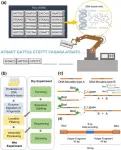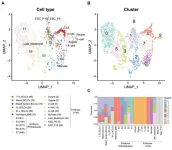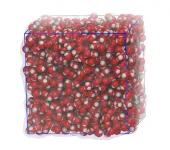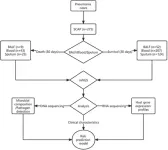(Press-News.org) A new form of agricultural pest control could one day take root—one that treats crop infestations deep under the ground in a targeted manner with less pesticide.
Engineers at the University of California San Diego have developed nanoparticles, fashioned from plant viruses, that can deliver pesticide molecules to soil depths that were previously unreachable. This advance could potentially help farmers effectively combat parasitic nematodes that plague the root zones of crops, all while minimizing costs, pesticide use and environmental toxicity.
Controlling infestations caused by root-damaging nematodes has long been a challenge in agriculture. One reason is that the types of pesticides used against nematodes tend to cling to the top layers of soil, making it tough to reach the root level where nematodes wreak havoc. As a result, farmers often resort to applying excessive amounts of pesticide, as well as water to wash pesticides down to the root zone. This can lead to contamination of soil and groundwater.
To find a more sustainable and effective solution, a team led by Nicole Steinmetz, a professor of nanoengineering at the UC San Diego Jacobs School of Engineering and founding director of the Center for Nano-ImmunoEngineering, developed plant virus nanoparticles that can transport pesticide molecules deep into the soil, precisely where they are needed. The work is detailed in a paper published in Nano Letters.
Steinmetz’s team drew inspiration from nanomedicine, where nanoparticles are being created for targeted drug delivery, and adapted this concept to agriculture. This idea of repurposing and redesigning biological materials for different applications is also a focus area of the UC San Diego Materials Research Science and Engineering Center (MRSEC), of which Steinmetz is a co-lead.
“We’re developing a precision farming approach where we’re creating nanoparticles for targeted pesticide delivery,” said Steinmetz, who is the study’s senior author. “This technology holds the promise of enhancing treatment effectiveness in the field without the need to increase pesticide dosage.”
The star of this approach is the tobacco mild green mosaic virus, a plant virus that has the ability to move through soil with ease. Researchers modified these virus nanoparticles, rendering them noninfectious to crops by removing their RNA. They then mixed these nanoparticles with pesticide solutions in water and heated them, creating spherical virus-like nanoparticles packed with pesticides through a simple one-pot synthesis.
This one-pot synthesis offers several advantages. First, it is cost-effective, with just a few steps and a straightforward purification process. The result is a more scalable method, paving the way toward a more affordable product for farmers, noted Steinmetz. Second, by simply packaging the pesticide inside the nanoparticles, rather than chemically binding it to the surface, this method preserves the original chemical structure of the pesticide.
“If we had used a traditional synthetic method where we link the pesticide molecules to the nanoparticles, we would have essentially created a new compound, which will need to go through a whole new registration and regulatory approval process,” said study first author Adam Caparco, a postdoctoral researcher in Steinmetz’s lab. “But since we’re just encapsulating the pesticide within the nanoparticles, we’re not changing the active ingredient, so we won’t need to get new approval for it. That could help expedite the translation of this technology to the market.”
Moreover, the tobacco mild green mosaic virus is already approved by the Environmental Protection Agency (EPA) for use as an herbicide to control an invasive plant called the tropical soda apple. This existing approval could further streamline the path from lab to market.
The researchers conducted experiments in the lab to demonstrate the efficacy of their pesticide-packed nanoparticles. The nanoparticles were watered through columns of soil and successfully transported the pesticides to depths of at least 10 centimeters. The solutions were collected from the bottom of the soil columns and were found to contain the pesticide-packed nanoparticles. When the researchers treated nematodes with these solutions, they eliminated at least half of the population in a petri dish.
While the researchers have not yet tested the nanoparticles on nematodes lurking beneath the soil, they note that this study marks a significant step forward.
“Our technology enables pesticides meant to combat nematodes to be used in the soil,” said Caparco. “These pesticides alone cannot penetrate the soil. But with our nanoparticles, they now have soil mobility, can reach the root level, and potentially kill the nematodes.”
Future research will involve testing the nanoparticles on actual infested plants to assess their effectiveness in real-world agricultural scenarios. Steinmetz’s lab will perform these follow-up studies in collaboration with the U.S. Horticultural Research Laboratory. Her team has also established plans for an industry partnership aimed at advancing the nanoparticles into a commercial product.
Paper title: “Delivery of Nematicides Using TMGMV-Derived Spherical Nanoparticles.” Co-authors include Ivonne Gonzalez-Gamboa, Samuel S. Hays and Jonathan K. Pokorski, UC San Diego.
This work was supported in part by the U.S. Department of Agriculture (grants NIFA-2020-67021-31255 and NIFA-2022-67012-36698), the National Science Foundation (CMMI 1901713) and the UC San Diego Materials Research Science and Engineering Center (MRSEC), which is supported by the National Science Foundation (grant DMR-2011924). This work was performed in part at the San Diego Nanotechnology Infrastructure (SDNI) at UC San Diego, a member of the National Nanotechnology Coordinated Infrastructure, which is supported by the National Science Foundation (grant ECCS-1542148). This work was also performed in part at the UC San Diego Department of Neurosciences Microscopy Core, which is supported by the National Institutes of Health (NINDS P30NS047101).
END
Nanoparticles made from plant viruses could be farmers’ new ally in pest control
2023-09-21
ELSE PRESS RELEASES FROM THIS DATE:
Social vs. language role: researchers question function of two brain areas
2023-09-21
A research team led by Prof. LIN Nan from the Institute of Psychology of the Chinese Academy of Sciences found that during sentence processing, the neural activity of two canonical language areas, i.e., the left ventral temporoparietal junction (vTPJ) and the lateral anterior temporal lobe (lATL), is associated with social-semantic working memory rather than language processing per se.
The study was published in Nature Human Behaviour on Sept. 21.
Language and social cognition are two deeply interrelated abilities of the human species, but have traditionally been studied ...
Inauguration ceremony of carbon future
2023-09-21
On September 17th, 2023, Carbon Future, an international interdisciplinary journal sponsored by Tsinghua University, has been officially inaugurated.
Carbon Future is an open access, peer-reviewed and international interdisciplinary journal that reports carbon-related materials and processes, including carbon materials, catalysis, energy conversion and storage, as well as low carbon emission process and engineering. The journal is published quarterly by Tsinghua University Press, and publicly released on SciOpen, an internationally digital ...
Revolutionizing data storage: DNA movable-type system paves the way for sustainable data storage technology
2023-09-21
In a groundbreaking study published in Engineering, researchers have developed a revolutionary method for data storage using DNA. The paper titled “Engineering DNA Materials for Sustainable Data Storage Using a DNA Movable-Type System” introduces a novel approach that utilizes DNA fragments, referred to as “DNA movable types,” for data writing, thereby eliminating the need for costly and environmentally hazardous DNA synthesis.
DNA molecules have long been recognized as green materials ...
NIH center grant bolsters male contraceptive research
2023-09-21
Weill Cornell Medicine has received a three-year, nearly $6 million grant to lead one of three national contraceptive research centers. The grant from the Eunice Kennedy Shriver National Institute of Child Health and Human Development, part of the National Institutes of Health, will fund the Weill Cornell Medicine Contraception Development Research Center. Led by Drs. Jochen Buck and Lonny Levin, both professors of pharmacology at Weill Cornell Medicine, the center will focus on developing an on-demand male contraceptive.
“It’s an honor to be selected for a second time for this award,” Dr. Levin ...
Supportive later-life social relationships mediate the risk of severe frailty in adults who had negative childhood experiences
2023-09-21
INDIANAPOLIS -- Frailty is a serious concern in later-life adults due to its association with additional health risks including disability, falls, hospitalization and mortality. The prevalence of frailty has risen over time; about 15 percent of those aged 65 years and older are considered frail.
In one of the first studies to analyze the mediating effects of social relationships in the relationship between childhood experiences and frailty, Regenstrief Research Scientist Monica M. Williams-Farrelly, PhD, has found ...
Towards a better understanding of early human embryonic development
2023-09-21
The onset of embryo-specific gene transcription, also known as embryonic genome activation (EGA), is a crucial step in the developmental journey of an organism. Although EGA has been studied to some extent in mice, human EGA remains largely unexplored, mainly due to the lack of novel in vitro cell models and ethical restrictions on the usage of human embryos. Thus, cell models resembling the human blastomere stage—when the embryo undergoes a cell duplication process—are necessary to study the earliest stages of human EGA and understand the events that occur during early embryonic development.
To ...
Evaluating the shear viscosity of different water models
2023-09-21
Water is one of the most abundant substances on Earth and partakes in countless biological, chemical, and ecological processes. Thus, understanding its behavior and properties is essential in a wide variety of scientific and applied fields. To do so, researchers have developed various water models to reproduce the behavior of bulk water in molecular simulations. While these simulations can provide valuable insights into the specific properties of water, selecting an appropriate model for the system under study is crucial. ...
Precision treatment for pneumonia care: metagenomic sequencing takes the lead
2023-09-21
Community-acquired pneumonia (CAP) is a major infectious disease worldwide and contributes to high mortality and massive economic burden. Hospital mortality among the severe CAP (SCAP) remains high, ranging from 25% to more than 50%.
Early identification of patients at high risk of death is essential for improving patient outcomes. However, predicting outcomes in patients with SCAP is challenging, as the disease is complex and influenced by various factors, including the types of pathogen causing the infection, the host immune response, and underlying medical conditions.
In this study published in eBioMedicine (a Lancet publication), a team led by Dr. Jinmin Ma, BGI Genomics Infection ...
Curiosity about religion is viewed as morally virtuous, new research finds
2023-09-21
People from diverse religious backgrounds in the United States view curiosity about religion as morally virtuous, according to new research published in Social Psychological and Personality Science. Atheists also view this curiosity as moral, although less moral than a lack of religious curiosity.
Previous research has examined what makes people curious and how curiosity helps people learn new information, but psychologists know less about how displaying curiosity is viewed by other people. The current research finds that people ...
Scholarships awarded to high school students committed to whole body wellness
2023-09-21
DALLAS, September 21, 2023 — Supporting the next generation of health advocates, the American Heart Association awards five high school seniors with $1,000 college scholarships to energize their commitment to community health through service-learning opportunities. The grants are a part of the American Heart Challenge™, a school-based program that helps middle and high school students feel good about their health, while doing good for the community.
The American Heart Association, devoted ...




